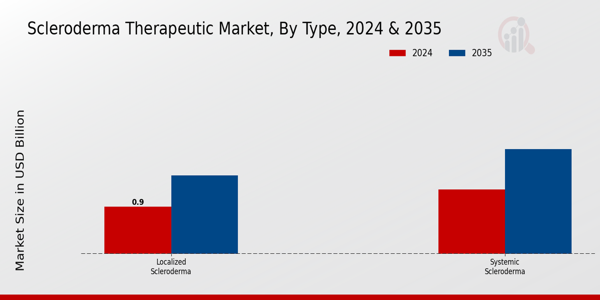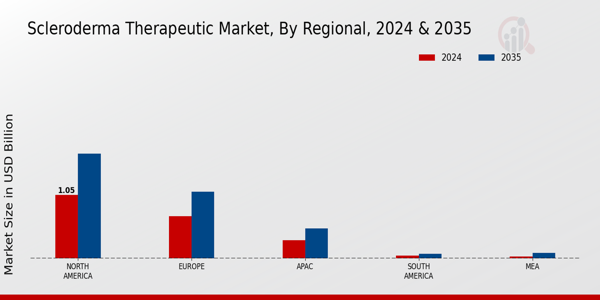Scleroderma Therapeutics Market Overview
As per MRFR analysis, the Scleroderma Therapeutics Market Size was estimated at 2.04 (USD Billion) in 2023.The Scleroderma Therapeutic Market is expected to grow from 2.13(USD Billion) in 2024 to 3.5 (USD Billion) by 2035. The Scleroderma Therapeutics Market CAGR (growth rate) is expected to be around 4.62% during the forecast period (2025 - 2035).
Key Scleroderma Therapeutics Market Trends Highlighted
greater patient numbers, improved treatment options, and greater illness awareness are all contributing to the substantial rise of the global scleroderma therapeutics market. Novel treatments are being developed as a result of an increase in research efforts aimed at comprehending the fundamental mechanisms of scleroderma.
Furthermore, the need for efficient treatments is being driven by the rising prevalence of autoimmune disorders and scleroderma in women. The market is expanding as a result of increased regulatory support for new drug approvals, offering pharmaceutical businesses a bright future.
Amid these developments, there are numerous opportunities for stakeholders to explore. Companies can focus on developing targeted therapies and personalized medicine approaches that cater to individual patient profiles. Investing in biotechnology innovations and expanding clinical trials can help capture a larger share of the market.
Collaborations and partnerships between research institutions and pharmaceutical companies may lead to quicker advancements in treatment modalities. Furthermore, exploring markets in developing regions where awareness is increasing can present untapped potential for growth.
In recent times, there has been a noticeable trend toward the utilization of biologics and new small molecule therapies targeting specific scleroderma symptoms.
There is also a shift towards combination therapies that may offer enhanced efficacy. Patients are increasingly becoming involved in their treatment options and are seeking information and support, leading to the rise of patient advocacy groups.
Digital health technologies, including telehealth and mobile health applications, are being integrated into treatment plans, facilitating better management of the disease. Overall, these trends indicate a dynamic and evolving market landscape, creating new avenues for enhanced patient care and therapeutic interventions.

Source: Primary Research, Secondary Research, MRFR Database and Analyst Review
Scleroderma Therapeutics Market Drivers
Increasing Prevalence of Scleroderma
The growing prevalence of scleroderma across the globe is a significant driver for the expansion of the Global Scleroderma Therapeutics Market. This increase can be attributed to several factors, including rising awareness regarding autoimmune diseases, better diagnostic techniques, and improved healthcare infrastructure.
As more individuals are diagnosed with scleroderma, the demand for effective treatment options is expected to surge. Scleroderma, characterized by the hardening and tightening of the skin and connective tissues, often requires comprehensive management, which includes pharmacological interventions targeted at various symptoms such as skin thickening, digestive complications, and vascular changes.
As healthcare providers become more adept at recognizing the signs and symptoms of the disease, patients are more likely to seek medical treatment early on. This early intervention can lead to better clinical outcomes and necessitate more therapies tailored to address this complex condition.
The market is also expected to benefit from collaborative efforts between researchers and pharmaceutical companies focusing on discovering new treatment modalities.
Additionally, the demographic shift towards an aging population increases the likelihood of scleroderma diagnosis, given its higher prevalence in older adults, thus further elevating the demand for therapeutic solutions within the Global Scleroderma Therapeutics Market.
Furthermore, increased funding for research and development into scleroderma treatments means that promising new therapies can be brought to market, meeting the needs of an underserved patient population who may currently have few effective options available. Therefore, the rising incidence of scleroderma remains a crucial driver for market growth in the upcoming years.
Advancements in Therapeutic Options
Innovations in therapeutic options and drug formulations are significantly influencing the Global Scleroderma Therapeutics Market. Recently, a variety of new treatments have been developed, including targeted therapies and biologics, which have shown promise in managing the symptoms of scleroderma more effectively than traditional therapies.
These advancements not only improve patient outcomes but also enhance the quality of life for individuals suffering from this challenging condition. The ongoing research into both existing and novel treatment pathways is expected to fuel the growth of the market as more effective therapies become available, thereby attracting both patients and healthcare providers to explore and adopt new solutions.
Rising Awareness and Education
Growing awareness and education surrounding scleroderma contribute significantly to the expansion of the Global Scleroderma Therapeutics Market. Increased educational initiatives by patient advocacy groups, healthcare providers, and governments have led to a better understanding and recognition of the disease.
Enhanced awareness allows for earlier diagnosis and intervention, directly impacting treatment efficacy and patient prognosis. Furthermore, it encourages patients to seek medical advice sooner, leading to higher therapy demand and potentially expanding the market for therapeutic interventions. This surge in awareness helps reduce stigma and leads to larger populations being treated, thus driving market growth.
Scleroderma Therapeutics Market Segment Insights
Scleroderma Therapeutics Market Type Insights
The Global Scleroderma Therapeutics Market exhibited a notable valuation, demonstrating its growing significance within the healthcare landscape. As the market progressed, it showcased a comprehensive segmentation, particularly focusing on the types of scleroderma.
Within this framework, Localized Scleroderma and Systemic Scleroderma emerged as the primary categories. The Localized Scleroderma segment held a notable share, valued at 0.9 USD Billion in 2024, and is expected to rise to 1.5 USD Billion by 2035.
This segment was crucial because it primarily affected the skin and underlying tissues, drawing attention to specialized therapies targeting these manifestations.
Alternatively, the Systemic Scleroderma segment demonstrated an even larger market presence, starting at 1.23 USD Billion in 2024 and expanding to 2.0 USD Billion by 2035. The significant valuation of Systemic Scleroderma underlined its impact, as this form of scleroderma can affect multiple organs, necessitating a diverse range of therapeutic approaches.
Moreover, the rising prevalence of scleroderma, combined with advancements in drug development and new treatment options, bolsters the market growth. Both Localized and Systemic Scleroderma presented distinct challenges and treatment needs, leading to a varied landscape of therapeutic interventions tailored to patient needs.
Market trends indicated a growing focus on research and development, aiming to enhance treatment efficacy and patient outcomes across the Global Scleroderma Therapeutics Market. As the market evolves, opportunities arise for innovative therapeutic solutions, making both segments vital to the overall landscape, with Systemic Scleroderma clearly dominating in terms of market valuation and complexity.
This segmentation offered insights into patient demographics and treatment accessibility, reflecting broader patterns in the healthcare market. Overall, the emphasis on type segmentation not only helped in understanding the intricacies of the Scleroderma Therapeutics Market but also facilitated targeted strategies to improve therapeutic practices and patient care across diverse populations.

Source: Primary Research, Secondary Research, MRFR Database and Analyst Review
Scleroderma Therapeutics Market Treatment Method Insights
The Global Scleroderma Therapeutics Market, particularly in the Treatment Method segment, is poised for significant growth. The increasing prevalence of scleroderma is a key driver for market expansion, coupled with advancements in treatment methodologies.
Treatment approaches encompass various categories, including Immunosuppressants, which play a vital role in managing autoimmune symptoms and slowing disease progression. Biologics have gained traction for their targeted mechanisms, effectively addressing specific components of the disease.
Corticosteroids remain essential for reducing inflammation and alleviating symptoms. Symptomatic Treatments are crucial for enhancing the quality of life, focusing on pain management and functional improvement. Antifibrotic Agents are increasingly important in managing fibrosis, reflecting a vital shift in treatment strategies.
The diversity within the Global Scleroderma Therapeutics Market segmentation allows for tailored therapies to meet patient needs, illuminating a pathway for sustained market growth and innovation. As the market evolves, the focus on effective treatment methods highlights opportunities to improve patient outcomes in the coming years.
Scleroderma Therapeutics Market Route of Administration Insights
The Route of Administration segment within the Global Scleroderma Therapeutics Market plays a crucial role in determining treatment efficacy and patient adherence. The market segmentation reveals diverse routes, including Oral, Injectable, and Topical, each offering unique benefits tailored to patient needs. Oral administration is often preferred for its convenience and ease of use, fostering better patient compliance.
Injectable therapies are significant due to their ability to deliver potent drugs directly into the bloodstream, providing rapid therapeutic effects. Topical formulations play an important role in addressing localized symptoms, allowing for targeted treatment with minimal systemic exposure.
This diversity in administration routes not only enhances patient choice but also drives market growth, as different patient profiles may require specific therapeutic approaches. The growing prevalence of scleroderma, coupled with ongoing research into new drug formulations, continues to present numerous opportunities within the Global Scleroderma Therapeutics Market.
As patient awareness increases, the demand for effective and accessible treatment options across various routes of administration is also expected to rise.
Scleroderma Therapeutics Market End User Insights
Hospitals play a crucial role in this market, as they are often equipped with advanced technologies and specialists who can handle complex cases, making them a primary destination for scleroderma treatment. Meanwhile, Clinics are also significant, providing essential outpatient care that allows patients to receive timely services without the need for hospitalization, thus contributing to overall market growth.
Furthermore, home care has gained traction due to the increasing preference for at-home treatment options, allowing patients to manage their conditions more comfortably and efficiently. This segment addresses the growing demand for personalized healthcare and support, enhancing patient compliance and satisfaction.
Together, these End User categories drive the Global Scleroderma Therapeutics Market revenue through varied service delivery methods, each responding to distinct patient needs. The growth dynamics in these areas are significant, highlighting trends in patient-centric care and the evolving healthcare landscape.
Scleroderma Therapeutics Market Regional Insights
In this regional segmentation, North America dominated with a significant market value of 1.05 USD Billion in 2024 and is projected to grow to 1.73 USD Billion by 2035, holding a majority share due to advanced healthcare infrastructure and high disease awareness.
Europe followed, valued at 0.7 USD Billion in 2024, with its market projected to reach 1.1 USD Billion in 2035, reflecting an increasing focus on innovative treatment options. The APAC region, although smaller, gained traction, with a valuation of 0.3 USD Billion in 2024 and expected to reach 0.5 USD Billion by 2035, driven by rising healthcare investments.
South America and MEA were comparatively lesser markets, with values of 0.05 USD Billion and 0.03 USD Billion in 2024, respectively, but they experienced gradual growth.
The overall Global Scleroderma Therapeutics Market revenue reflected opportunities in untapped markets and highlighted the necessity for enhanced therapeutic solutions globally. With projected annual growth, the regional dynamics showcased how varied healthcare approaches affected market expansion, guiding industry stakeholders in strategic planning.

Source: Primary Research, Secondary Research, MRFR Database and Analyst Review
Scleroderma Therapeutics Market Key Players and Competitive Insights
The Global Scleroderma Therapeutics Market is significantly influenced by a variety of companies engaged in the development and distribution of innovative treatments for this chronic autoimmune disease.
As scleroderma can manifest in different forms with debilitating effects on a patient’s quality of life, the competition in the market is driven by the urgent demand for effective therapies that can manage symptoms and potentially modify disease progression.
Pharmaceutical companies are focusing on extensive research and development efforts, with a keen interest in understanding the underlying mechanisms of scleroderma, leading to a host of new treatment options.
These developments not only include traditional pharmaceuticals but also biological therapies that are tailored to individual patient needs. The competitive landscape is characterized by collaborations, mergers, and acquisitions as firms strive to enhance their product portfolios and gain a larger market share.
Amgen holds a strong position in the Global Scleroderma Therapeutics Market, owing to its robust pipeline of innovative therapies designed specifically for scleroderma. The company's commitment to research and development is underscored by substantial investments, allowing it to push the boundaries of treatment options available for scleroderma patients.
Amgen's established reputation in the biotechnology sector is complemented by its extensive experience in developing biologics that can target various pathways involved in autoimmune diseases, making it a formidable competitor.
Additionally, their strategic partnerships and collaborations with academic institutions and healthcare providers facilitate the advancement of their treatments through clinical trials, bringing new therapies closer to the market.
Amgen's strong focus on patient-centric approaches enhances its understanding of patient needs and drives the development of targeted therapies that are expected to deliver improved outcomes.
Horizon Therapeutics is another key player in the Global Scleroderma Therapeutics Market, known for its dedication to developing innovative treatments specifically for rare and complex diseases, including scleroderma. The company's strategic emphasis on patient engagement and understanding of unmet medical needs sets it apart from competitors.
Horizon Therapeutics leverages advanced research methodologies to identify and develop therapies aimed at different manifestations of scleroderma, with a promise to provide transformative care to those affected. With a portfolio of products that demonstrate efficacy in managing symptoms associated with scleroderma, the company has carved a niche for itself in the market.
Additionally, the company is well-regarded for its commitment to educational initiatives that empower patients and healthcare providers, fostering awareness about scleroderma and driving support for clinical research efforts in this area, which ultimately enhances their positioning within the overall therapeutic landscape.
Key Companies in the Scleroderma Therapeutics Market Include
- Amgen
- Horizon Therapeutics
- Eli Lilly
- Merck and Co
- Pfizer
- Incyte Corporation
- BristolMyers Squibb
- Actelion Pharmaceuticals
- Boehringer Ingelheim
- Novartis
- Sanofi
- Takeda Pharmaceutical
- Roche
- AstraZeneca
- Gilead Sciences
Scleroderma Therapeutic Market Developments
Recent developments in the Global Scleroderma Therapeutics Market have shown increased focus and investment from major pharmaceutical companies. Amgen and Horizon Therapeutics have been actively pursuing innovative treatments for scleroderma, aligned with heightened research activities to address this rare condition.
Eli Lilly and Merck & Co. have also engaged in clinical trials aimed at developing effective therapeutic solutions that can mitigate symptoms for patients affected by scleroderma.
Additionally, companies like Pfizer and Incyte Corporation have been reported to expand their portfolios to include treatments addressing systemic sclerosis, reflecting a growing market valuation driven by heightened awareness and demand for effective therapies.
Current affairs indicate that major players such as Bristol-Myers Squibb and Novartis are exploring partnerships and collaborations, potentially catalyzing advancements in the therapeutic landscape. Sanofi and Takeda Pharmaceutical are also in talks aimed at expanding their research capabilities in scleroderma treatments.
Notably, recent mergers and acquisitions efforts are being closely monitored, especially as companies like Roche and AstraZeneca aim to consolidate resources and expertise in this specialized market. Overall, the heightened market activity reflects a strategic pivot toward addressing unmet needs in scleroderma therapeutics.
Scleroderma Therapeutics Market Segmentation Insights
Scleroderma Therapeutics MarketTypeOutlook
- Localized Scleroderma
- Systemic Scleroderma
Scleroderma Therapeutics MarketTreatment MethodOutlook
- Immunosuppressants
- Biologics
- Corticosteroids
- Symptomatic Treatment
- Antifibrotic Agents
Scleroderma Therapeutics MarketRoute of AdministrationOutlook
Scleroderma Therapeutics MarketEnd UserOutlook
- Hospitals
- Clinics
- Homecare
Scleroderma Therapeutics MarketRegionalOutlook
- North America
- Europe
- South America
- Asia Pacific
- Middle East and Africa
| Attribute/Metric Source: |
Details |
| MARKET SIZE 2023 |
2.04(USD Billion) |
| MARKET SIZE 2024 |
2.13(USD Billion) |
| MARKET SIZE 2035 |
3.5(USD Billion) |
| COMPOUND ANNUAL GROWTH RATE (CAGR) |
4.62% (2025 - 2035) |
| REPORT COVERAGE |
Revenue Forecast, Competitive Landscape, Growth Factors, and Trends |
| BASE YEAR |
2024 |
| MARKET FORECAST PERIOD |
2025 - 2035 |
| HISTORICAL DATA |
2019 - 2024 |
| MARKET FORECAST UNITS |
USD Billion |
| KEY COMPANIES PROFILED |
Amgen, Horizon Therapeutics, Eli Lilly, Merck and Co, Pfizer, Incyte Corporation, BristolMyers Squibb, Actelion Pharmaceuticals, Boehringer Ingelheim, Novartis, Sanofi, Takeda Pharmaceutical, Roche, AstraZeneca, Gilead Sciences |
| SEGMENTS COVERED |
Type, Treatment Method, Route of Administration, End User, Regional |
| KEY MARKET OPPORTUNITIES |
Novel drug development initiatives, Increasing patient awareness programs, Expansion in emerging markets, Personalized medicine approaches, Growth of telemedicine services |
| KEY MARKET DYNAMICS |
Rising prevalence of scleroderma, Increasing R&D investment, Growth in biologics market, Awareness and early diagnosis, Support from patient advocacy groups |
| COUNTRIES COVERED |
North America, Europe, APAC, South America, MEA |
Frequently Asked Questions (FAQ) :
The Global Scleroderma Therapeutic Market is expected to be valued at 2.13 USD Billion in 2024.
By 2035, the market for Systemic Scleroderma is projected to reach 2.0 USD Billion.
North America is projected to have the largest market share, valued at 1.05 USD Billion in 2024.
The expected CAGR for the Global Scleroderma Therapeutic Market from 2025 to 2035 is 4.62%.
The market value for Localized Scleroderma is expected to be 0.9 USD Billion in 2024.
The European Scleroderma market is expected to grow to 1.1 USD Billion by 2035.
Major players include Amgen, Eli Lilly, Pfizer, and Merck and Co.
The APAC region's market for Scleroderma is expected to be valued at 0.3 USD Billion in 2024.
Key growth drivers include increasing awareness and advancements in therapeutics for Scleroderma.
The market value for the MEA region is expected to reach 0.09 USD Billion by 2035.
















